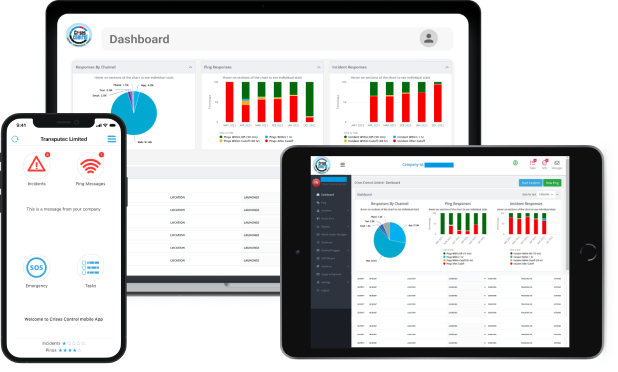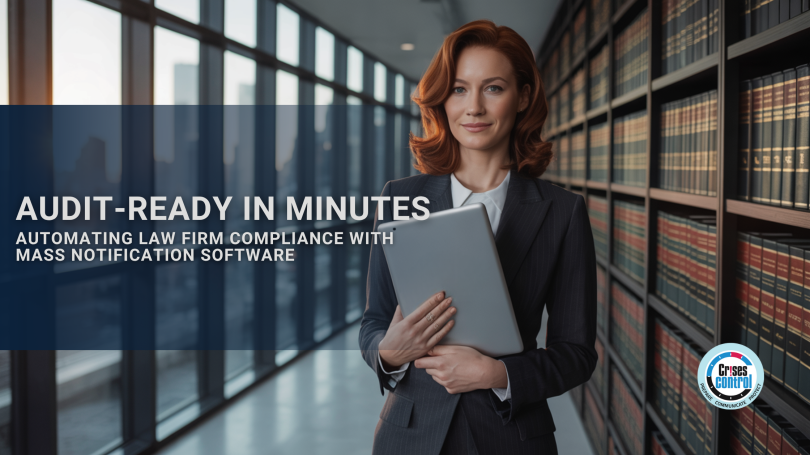Written by Anneri Fourie | Crises Control Executive
Introduction: The Compliance Problem You Can’t Ignore
When a serious incident strikes, like a data breach, cyberattack or service outage, your organisation is expected to do more than just react. Regulators want evidence that you responded correctly, involved the right people, communicated effectively and made decisions that can be defended later. That level of accountability isn’t optional anymore. It’s written into law.
Whether you’re governed by the General Data Protection Regulation (GDPR), the Solicitors Regulation Authority (SRA), or both, you’re expected to demonstrate how you handled the situation, and to do so quickly. The GDPR, for example, requires organisations to notify the relevant authority of a breach within 72 hours. The SRA expects law firms to self-report material compliance issues without delay.
The challenge? Keeping up with those requirements in the middle of a crisis, when pressure is high and time is short.
This is where mass notification software steps in as a powerful tool, not only for alerting teams, but for creating a reliable, time-stamped record of everything that happens. With the right system in place, you don’t just respond more effectively; you also stay prepared for audits without having to piece everything together afterwards.
In this blog, we’ll explain how automating compliance documentation using platforms like Crises Control can remove stress, reduce risk, and help you stay ahead of your legal and regulatory obligations.
Why You Need a Solid Audit Trail, Before Anyone Asks for It
When something goes wrong, regulators and internal stakeholders want clear answers. Questions like:
- Who was notified, and when?
- What actions were taken?
- What decisions were made, and by whom?
- Was the regulator notified within the required timeframe?
These aren’t just checklist items. They’re legal requirements. Failure to document your response properly could result in fines, penalties, or worse, loss of your licence to operate. For law firms and regulated industries, the stakes are even higher.
Trying to piece together this information after an incident is risky. Memory fades, email threads get lost, and critical details are often missed. Manual logs can be inconsistent or incomplete, especially if your team is working under pressure.
By automating how incidents are recorded and documented, organisations can ensure that nothing is left out and everything is ready for inspection. No scrambling. No guesswork. Just accurate, audit-ready evidence.
Automating Compliance: How Mass Notification Software Helps
Real-Time Logging of Every Action
From the moment an incident is declared, the right mass notification system starts working in the background. It automatically tracks:
- Who triggered the alert
- Who received notifications
- Who acknowledged the alert, and when
- What actions were taken
- Which decisions were made and by whom
This creates a precise timeline that can be reviewed, exported, and shared with regulators or internal teams. Because the system logs events as they happen, there’s no need to reconstruct the story afterwards.
Centralised Communication History
A common problem during audits is pulling together all the relevant communications. Email threads, phone calls, chat messages, it’s easy for these to end up scattered across different platforms.
Mass notification software brings all this together in one place. Every alert, response, escalation and acknowledgement is stored in a central log. If you need to show who was informed and what was said, the record is right there—timestamped and complete.
This centralised audit trail helps compliance officers demonstrate that the right steps were taken, and that regulatory timelines were met.
Documented Decision-Making
When regulators look at how you handled an incident, they don’t just care about what happened. They want to know why it happened, and why you responded the way you did.
An effective incident management platform helps you track:
- Who authorised key decisions
- What reasoning was recorded
- What steps were followed
- When regulators or customers were notified
Having this information clearly documented protects your team and supports your compliance case. If questioned later, you can show not just what was done, but why it made sense at the time.
Features That Matter for Law Firms and Regulated Sectors
For firms working under the SRA or GDPR, not all mass notification tools will be fit for purpose. You need more than just a way to send out alerts.
Some of the key features to look for include:
- Role-based alerts: Send the right messages to the right people, while protecting sensitive information.
- Pre-built regulatory workflows: Activate pre-approved responses to data breaches or compliance issues instantly.
- Automatic timestamping: Ensure every communication and action is logged in real time.
- Audit-ready export tools: Download complete logs with no manual work required.
- Secure storage: Keep sensitive records encrypted and accessible only to authorised users.
Crises Control is built with these needs in mind. It offers all of the above, with additional features designed to support legal, financial, and healthcare organisations facing tight regulatory obligations.
Real-World Example: Responding to a Data Breach
To understand how this works in practice, let’s look at a real-world scenario.
A medium-sized law firm in Manchester suffers a ransomware attack that locks users out of key systems. Within moments, Crises Control is activated:
- The IT and compliance teams are notified automatically via predefined groups.
- A GDPR breach workflow is launched, providing step-by-step guidance.
- Stakeholders receive messages with receipt tracking enabled.
- All acknowledgements, actions and communications are logged instantly in a central dashboard.
- The firm’s Data Protection Officer uses the audit log to submit a full report to the ICO within 72 hours.
When regulators follow up weeks later, the firm is ready. They’re able to present a full record of events, including who was notified, what was done, and when. Every detail is documented and searchable. The audit is passed without issue.
Without this system, that same firm might have spent days gathering partial records, missing key events and trying to rebuild timelines from memory.
Choosing the Right Incident Management Software for Compliance
With many incident response tools available, it’s important to choose one that supports your specific compliance requirements. Here are a few essential features to look for:
- Automated activity logs: Ensure everything is timestamped and searchable.
- Built-in reporting formats: Save time when responding to GDPR, SRA or other frameworks.
- Access controls: Limit visibility to sensitive data based on roles or responsibilities.
- Reliable mass alerting: Make sure messages reach the right people quickly and can be acknowledged.
- Secure cloud infrastructure: Data should be encrypted and stored in line with UK and EU privacy standards.
Crises Control offers all of these features in a single platform. It works across devices, integrates with your existing systems, and gives you full visibility of your incident response, without the need for manual tracking or guesswork.
If you’re looking for the best tools for GDPR and SRA compliance, Crises Control is worth a closer look.
Why Mass Notification Software is No Longer Optional
Some organisations still see mass notification software as a nice-to-have. But in regulated sectors, it’s fast becoming a core part of compliance infrastructure.
With regulators expecting timely, documented responses to incidents, manual processes no longer cut it. The time lost during manual logging, or the risk of missed details, can expose you to fines and legal consequences.
Automation doesn’t just make things easier. It makes them safer, faster, and more defensible. By putting a system like Crises Control in place, you’re building resilience, not just for crises, but for the scrutiny that follows them.
Conclusion: Get Audit-Ready Before the Audit Arrives
Regulatory audits often come without warning. The worst time to prepare your documentation is after an incident has already happened.
With Crises Control’s mass notification and incident management tools, you can automate the process of capturing evidence, streamline your responses, and make sure everything you do during an incident is clearly recorded and easy to retrieve.
The result? You stay compliant, reduce risk, and protect your reputation, all without adding more pressure to your team.
See how it works for yourself. Contact us today to book your free demo and take the first step towards becoming audit-ready in minutes, not months.
Request a FREE Demo

